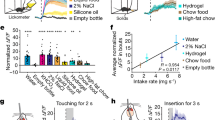Summary
The present study was concerned with quantifying and localizing the bulk stimulus that causes satiation inAplysia.
-
1.
Food-deprived animals were found to gain a mean of 15.4 ± 6.6 (S.D.) percent of body weight immediately following a meal of dried seaweed. The weight gain is largely accounted for by water ingested along with the dried seaweed (Fig. 3).
-
2.
Animals that were chronically food deprived required a larger amount of food to satiate, compared to animals that had been fed daily (Figs. 7, 8; Table 1); nevertheless, after satiation, the mean anterior gut contents were similar in all animals, regardless of the quantity of bulk consumed during the meal (Figs. 8, 9). The greater quantity of food eaten by the previously food-deprived animals can be quantitatively accounted for by the smaller amount of bulk present in their anterior gut before the meal (Fig. 8).
-
3.
Injection of high viscosity non-nutritive bulk which preferentially fills the anterior gut (Fig. 10) was capable of causing satiation (Figs. 11, 12), whereas injection of low viscosity bulk which preferentially fills the intestine did not cause satiation (Figs. 11, 12). Satiation also was not produced by injections of bulk into the hemocoel (Fig. 12).
The results suggest that satiation inAplysia is due to activation of mechanoreceptors associated solely with the anterior gut.
Similar content being viewed by others
References
Borer, K. T.: Control of food intake inOctopus briareus Rebson. J. comp. physiol. Psychol.75, 171–185 (1971)
Braley, S.A.: Acceptable plastic implants. In: Modern trends in biomechanics (ed. D.C. Simpson), p. 25–51. Great Britain: Butterworths 1970
Carefoot, T. H.: Studies on a sublittoral population ofAplysia punctata. J. Marine Biol. Assoc. U.K.47, 335–350 (1967)
Carew, T. J., Pinsker, H. M., Rubinson, K., Kandel, E. R.: Physiological and biochemical properties of neuromuscular transmission between identified motor neurons and gill muscle inAplysia. J. Neurophysiol.37, 1020–1040 (1974)
Cohen, J., Weiss, K. R., Kupfermann, I.: Physiology of the neuromuscular system of buccal muscle ofAplysia. Physiologist17, 198 (1974)
Dawson, J.: How to know the seaweeds. Dubuque, Iowa: Wm. C. Brown Company 1956
Dethier, V. G., Gelperin, A.: Hyperphagia in the blowfly. J. exp. Biol.47, 191–200 (1967)
Eales, N. B.: Aplysia. Liverpool Mar. Biol. Comm. Mem.24, 1–80 (1921)
Gelperin, A.: Control of crop emptying in the blowfly. J. Insect Physiol.12, 331–345 (1966a)
Gelperin, A.: Investigation of a foregut receptor essential to taste threshold regulation in the blowfly. J. Insect Physiol.12, 829–841 (1966b)
Gelperin, A.: Abdominal sensory neurons providing negative feedback to the feeding behavior of the blowfly. Z. vergl. Physiol.72, 17–31 (1971)
Gelperin, A., Dethier, V. G.: Long-term regulation of sugar intake by the blowfly. Physiol. Zool.40, 218–228 (1967)
Gwadz, R. W.: Regulation of blood meal size in the mosquito. J. Insect Physiol.15, 2039–2044 (1969)
Howells, H. H.: The structure and function of the alimentary canal ofAplysia punctata. Quart. J. micr. Sci.83, 357–397 (1936)
Jacobs, H. L., Sharma, K. M.: Taste versus calories: Sensory and metabolic signals in the control of food intake. Ann. N.Y. Acad. Sci.157, 1084–1125 (1969)
Janowitz, H. D.: Role of the gastrointestinal tract in regulation of food intake. In: Handbook of physiology, sect. 6: Alimentary canal vol. 1: Control of food and water intake. (ed. C. F. Code). Washington, D. C.: American Physiological Society 1967
Kupfermann, I.: Feeding behavior inAplysia: A simple system for the study of motivation. Behav. Biol.10, 1–26 (1974a)
Kupfermann, I.: Dissociation of the appetitive and consummatory phases of feeding behavior inAplysia: A lesion study. Behav. Biol.10, 89–97 (1974b)
Kupfermann, I., Cohen, J.: The control of feeding by identified neurons in the buccal ganglion ofAplysia. Amer. Zool.11, 602 (1971)
Kupfermann, I., Weiss, K.: Functional studies on the metacerebral cells inAplysia. Soc. Neurosciences4, 296 (1974)
Le Magnen, J.: Advances in studies on the physiological control and regulation of food intake. In: Progress in physiological psychology, vol. 4 (eds. E. Stellar, J. M. Sprague). New York: and London: Academic Press 1971
Long, S. J.: Preparing vinyl acetate models of ophistobranch alimentary tracts. Molluscan Digest2, 129–130 (1972)
MacFarland, F. M.: The ophistobranchiate mollusca of the Branner-Agassiz expedition to Brazil. Standford: University Press 1909
MacFarland, F. M.: Studies of ophisthobranchiate mollusks of the Pacific Coast of North America. San Francisco: California Academy of Sciences 1966
Madrell, S. H. P.: Control of ingestion inRhodnius prolixus. Nature (Lond.)198, 210 (1963)
Martin, A. W., Harrison, F. M., Huston, M. J., Stuart, D. M.: The blood volumes of some representative molluscs. J. exp. Biol.35, 260–279 (1958)
Panksepp, J.: Hypothalamic regulation of energy balance and feeding behavior. Fed. Proc.33, 1150–1165 (1974)
Smith, G. P., Gibbs, J., Young, R. C.: Cholecystokinin and intestinal satiety in the rat. Fed. Proc.33, 1146–1149 (1974)
Susswein, A. J.: Studies on satiation of feeding in the marine molluscAplysia californica. Ph. D. Dissertation, New York University (1974)
Susswein, A. J., Kupfermann, I.: Bulk as a signal regulating feeding behavior inAplysia californica. Soc. Neuroscience3, 239 (1973)
Susswein, A. J., Kupfermann, I.: Effects of satiation on the biting reflex inAplysia. Soc. Neuroscience4, 296 (1974)
Susswein, A. J., Kupfermann, I.: Bulk as a stimulus for satiation inAplysia. Behav. Biol.13, 203–209 (1975)
Treherne, J. E.: Glucose absorbtion in the cockroach. J. exp. Biol.34, 478–485 (1957)
Author information
Authors and Affiliations
Additional information
We would like to thank Drs. T. Carew, V. Castellcci and E. Kandel for their comments on earlier drafts of this manuscript, S. Laskin for assistance in data analysis, and S. Hauser and K. Hilten for assistance with the illustrations. This research was supported by NINDS Grant 10757, by P.H.S. Predoctoral Training Grant to the Department of Physiology, N.Y.U. Medical School, 71176-234, and by Sloan Foundation 360-3070-2772.
Rights and permissions
About this article
Cite this article
Susswein, A.J., Kupfermann, I. Localization of bulk stimuli underlying satiation inAplysia . J. Comp. Physiol. 101, 309–328 (1975). https://doi.org/10.1007/BF00657048
Received:
Issue Date:
DOI: https://doi.org/10.1007/BF00657048




